check engine Lexus IS250 2006 Using the audio system / LEXUS 2006 IS350/250 THROUGH APRIL 2006 PROD. OWNER'S MANUAL (OM53508U)
[x] Cancel search | Manufacturer: LEXUS, Model Year: 2006, Model line: IS250, Model: Lexus IS250 2006Pages: 433, PDF Size: 10.9 MB
Page 4 of 433
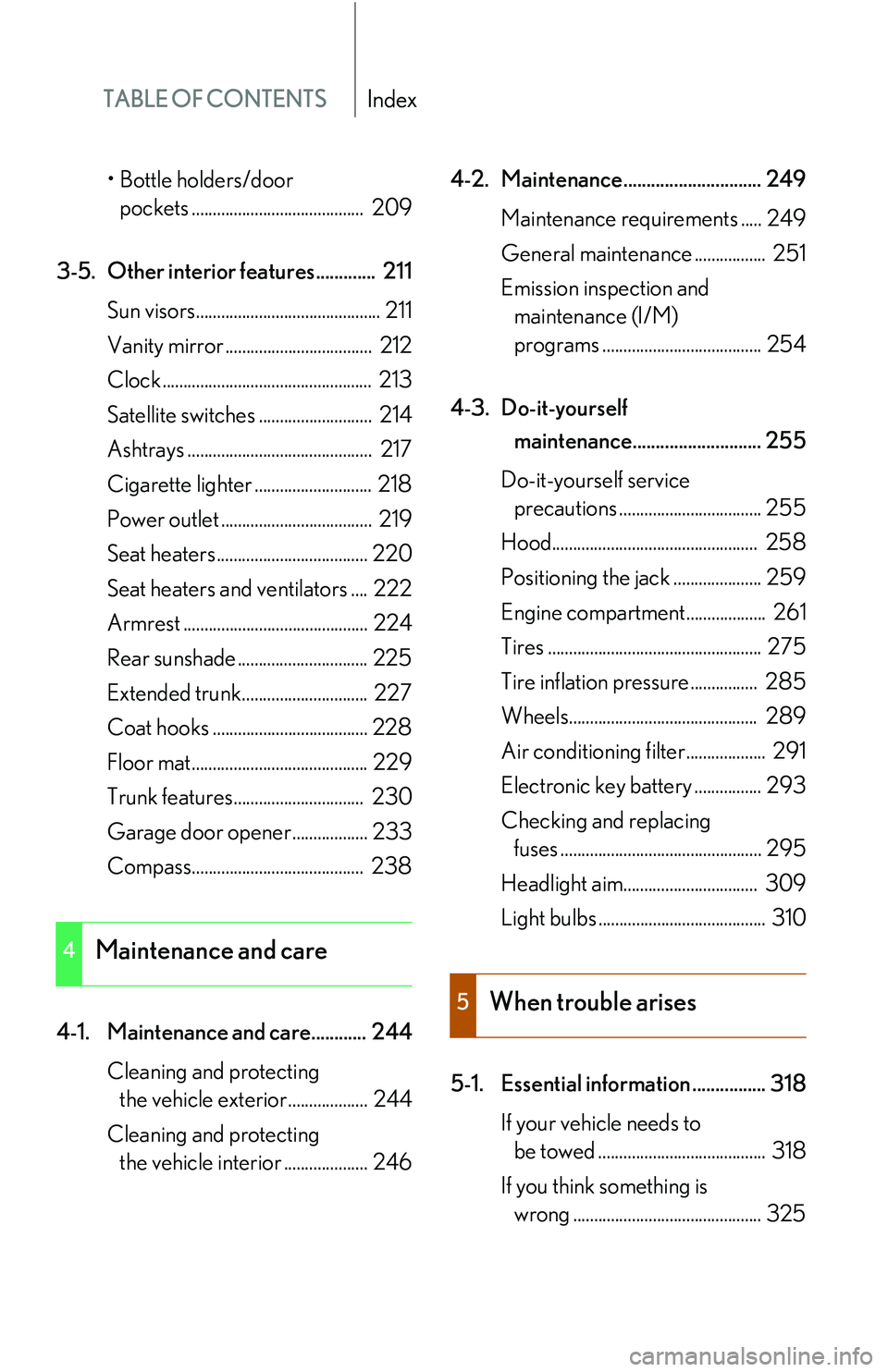
TABLE OF CONTENTSIndex
• Bottle holders/door pockets ......................................... 209
3-5. Other interior features............. 211 Sun visors............................................ 211
Vanity mirror ................................... 212
Clock .................................................. 213
Satellite switch es ........................... 214
Ashtrays ............................................ 217
Cigarette lighter ............................ 218
Power outlet .................................... 219
Seat heaters .................................... 220
Seat heaters and ve ntilators .... 222
Armrest ............................................ 224
Rear sunshade ............................... 225
Extended trunk.............................. 227
Coat hooks ..................................... 228
Floor mat.......................................... 229
Trunk features............................... 230
Garage door opener .................. 233
Compass......................................... 238
4-1. Maintenance and care............ 244 Cleaning and protecting the vehicle exterior................... 244
Cleaning and protecting the vehicle interior .................... 246 4-2. Maintenance.............................. 249
Maintenance requirements ..... 249
General maintena nce ................. 251
Emission inspection and maintenance (I/M)
programs ...................................... 254
4-3. Do-it-yourself maintenance............................ 255
Do-it-yourself service precautions .................................. 255
Hood................................................. 258
Positioning the jack ..................... 259
Engine compartment................... 261
Tires ................................................... 275
Tire inflation pressure................ 285
Wheels............................................. 289
Air conditioning filter................... 291
Electronic key battery ................ 293
Checking and replacing fuses ................................................ 295
Headlight aim................................ 309
Light bulbs ........................................ 310
5-1. Essential information ................ 318 If your vehicle needs to be towed ........................................ 318
If you think something is wrong ............................................. 325
4Maintenance and care
5When trouble arises
Page 43 of 433
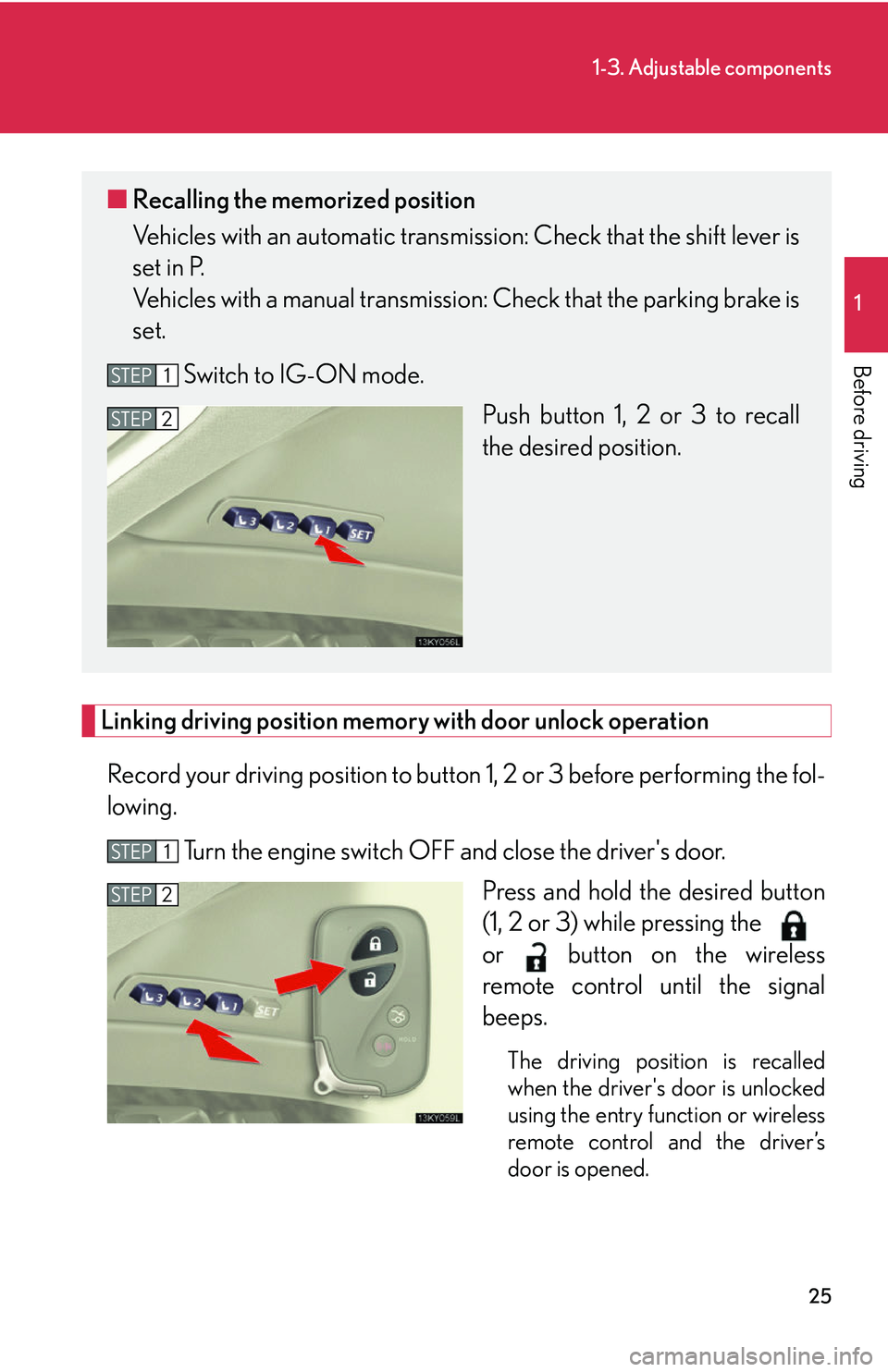
25
1-3. Adjustable components
1
Before driving
Linking driving position memory with door unlock operationRecord your driving position to button 1, 2 or 3 before performing the fol-
lowing.
Turn the engine switch OFF and close the driver's door. Press and hold the desired button
(1, 2 or 3) while pressing the
or button on the wireless
remote control until the signal
beeps.
The driving position is recalled
when the driver's door is unlocked
using the entry function or wireless
remote control and the driver’s
door is opened.
■Recalling the memorized position
Vehicles with an automatic transmis sion: Check that the shift lever is
set in P.
Vehicles with a manual transmissi on: Check that the parking brake is
set.
Switch to IG-ON mode. Push button 1, 2 or 3 to recall
the desired position.
STEP1
STEP2
STEP1
STEP2
Page 70 of 433
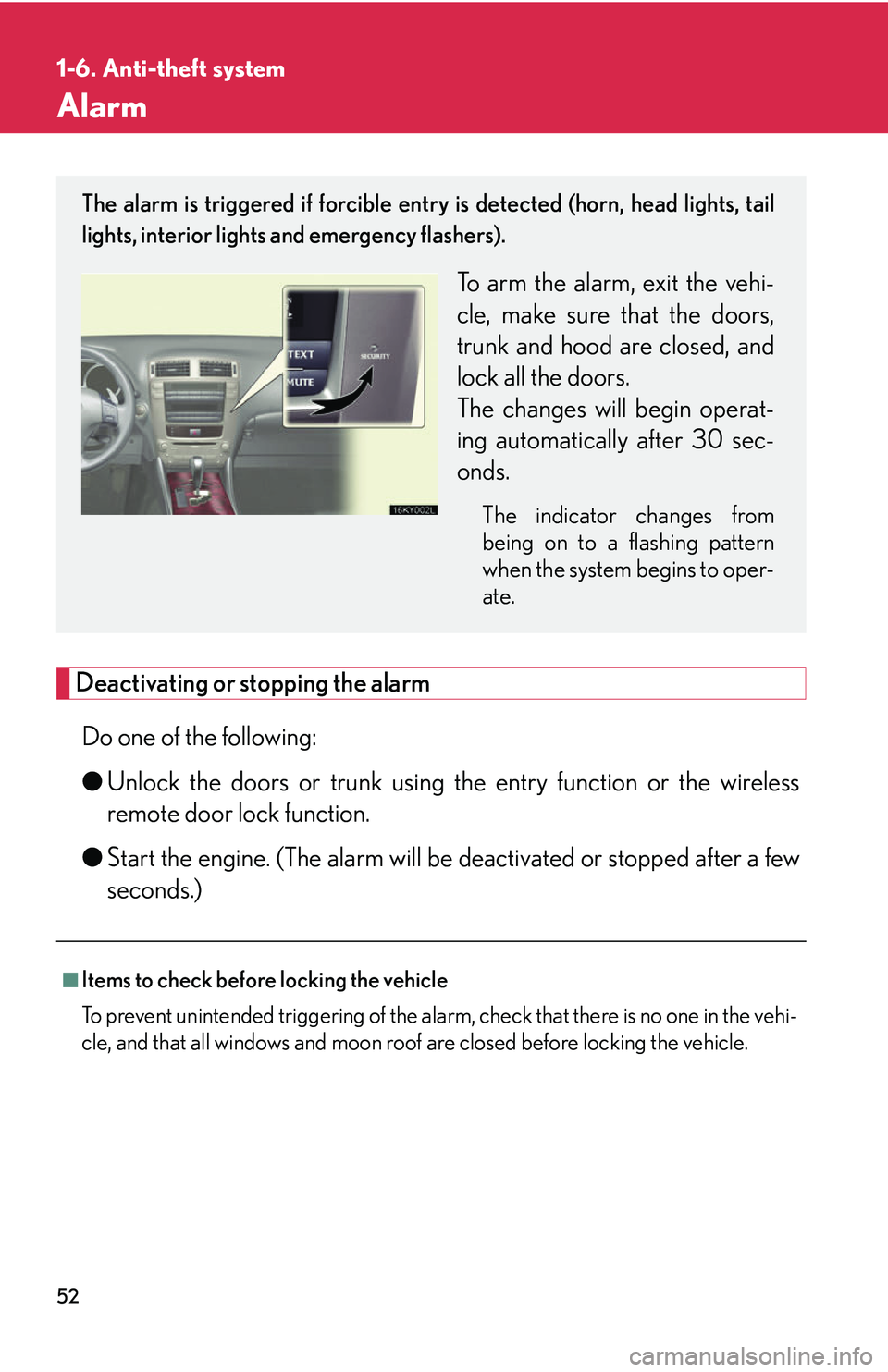
52
1-6. Anti-theft system
Alarm
Deactivating or stopping the alarmDo one of the following:
● Unlock the doors or trunk using th e entry function or the wireless
remote door lock function.
● Start the engine. (The alarm will be deactivated or stopped after a few
seconds.)
■Items to check before locking the vehicle
To prevent unintended triggering of the alar m, check that there is no one in the vehi-
cle, and that all windows and moon roof are closed before locking the vehicle.
The alarm is triggered if forcible entry is detected (horn, head lights, tail
lights, interior lights and emergency flashers).
To arm the alarm, exit the vehi-
cle, make sure that the doors,
trunk and hood are closed, and
lock all the doors.
The changes will begin operat-
ing automatically after 30 sec-
onds.
The indicator changes from
being on to a flashing pattern
when the system begins to oper-
ate.
Page 102 of 433
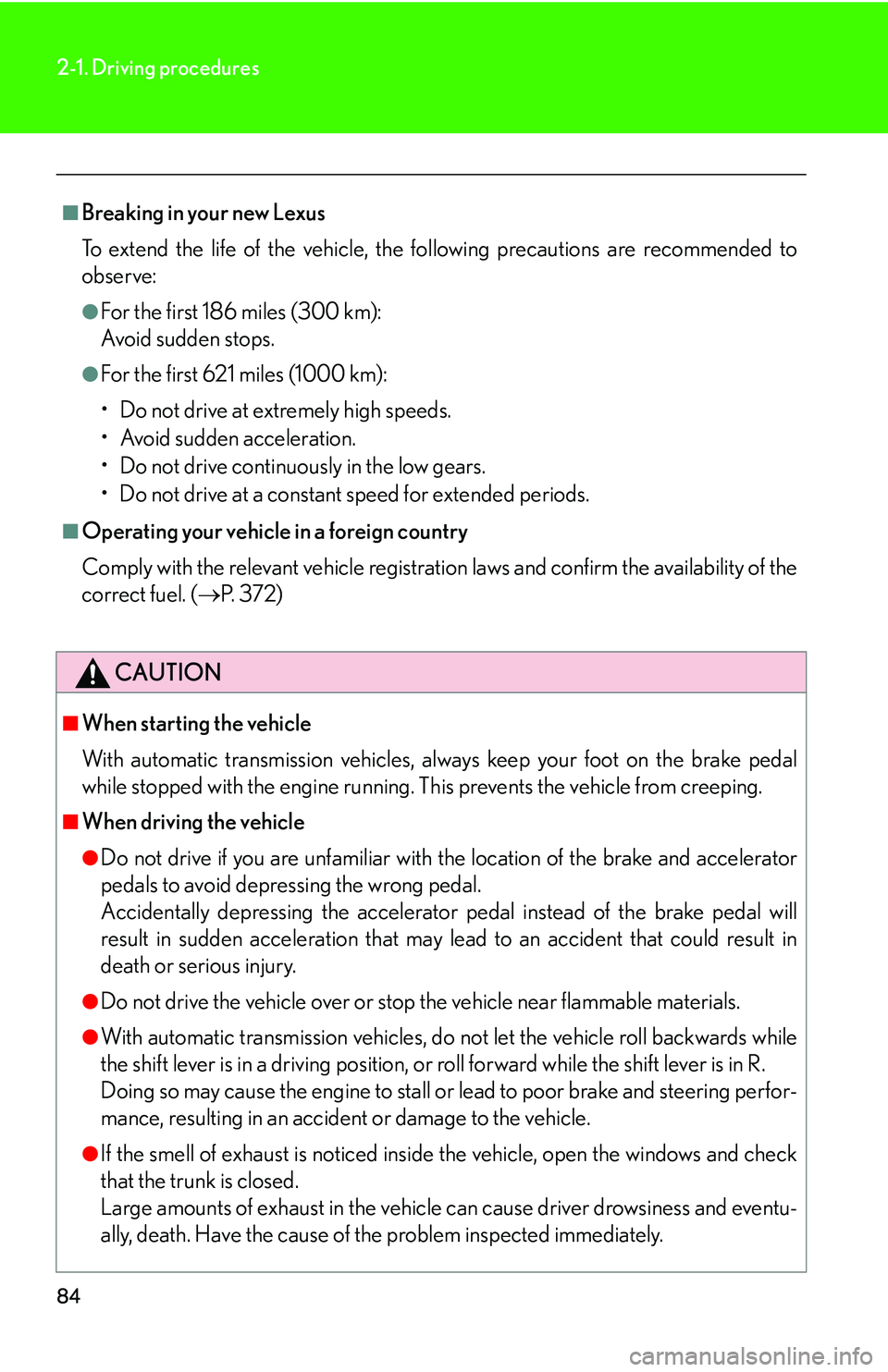
84
2-1. Driving procedures
■Breaking in your new Lexus
To extend the life of the vehicle, the following precautions are recommended to
observe:
●For the first 186 miles (300 km):
Avoid sudden stops.
●For the first 621 miles (1000 km):
• Do not drive at extremely high speeds.
• Avoid sudden acceleration.
• Do not drive continuously in the low gears.
• Do not drive at a constant speed for extended periods.
■Operating your vehicle in a foreign country
Comply with the relevant vehicle registration laws and confirm the availability of the
correct fuel. (P. 3 7 2 )
CAUTION
■When starting the vehicle
With automatic transmission vehicles, always keep your foot on the brake pedal
while stopped with the engine running. This prevents the vehicle from creeping.
■When driving the vehicle
●Do not drive if you are unfamiliar with the location of the brake and accelerator
pedals to avoid depressing the wrong pedal.
Accidentally depressing the accelerator pedal instead of the brake pedal will
result in sudden acceleration that may le ad to an accident that could result in
death or serious injury.
●Do not drive the vehicle over or stop the vehicle near flammable materials.
●With automatic transmission vehicles, do not let the vehicle roll backwards while
the shift lever is in a driving position, or roll forward while the shift lever is in R.
Doing so may cause the engine to stall or lead to poor brake and steering perfor-
mance, resulting in an accident or damage to the vehicle.
●If the smell of exhaust is noticed inside the vehicle, open the windows and check
that the trunk is closed.
Large amounts of exhaust in the vehicle can cause driver drowsiness and eventu-
ally, death. Have the cause of the problem inspected immediately.
Page 103 of 433
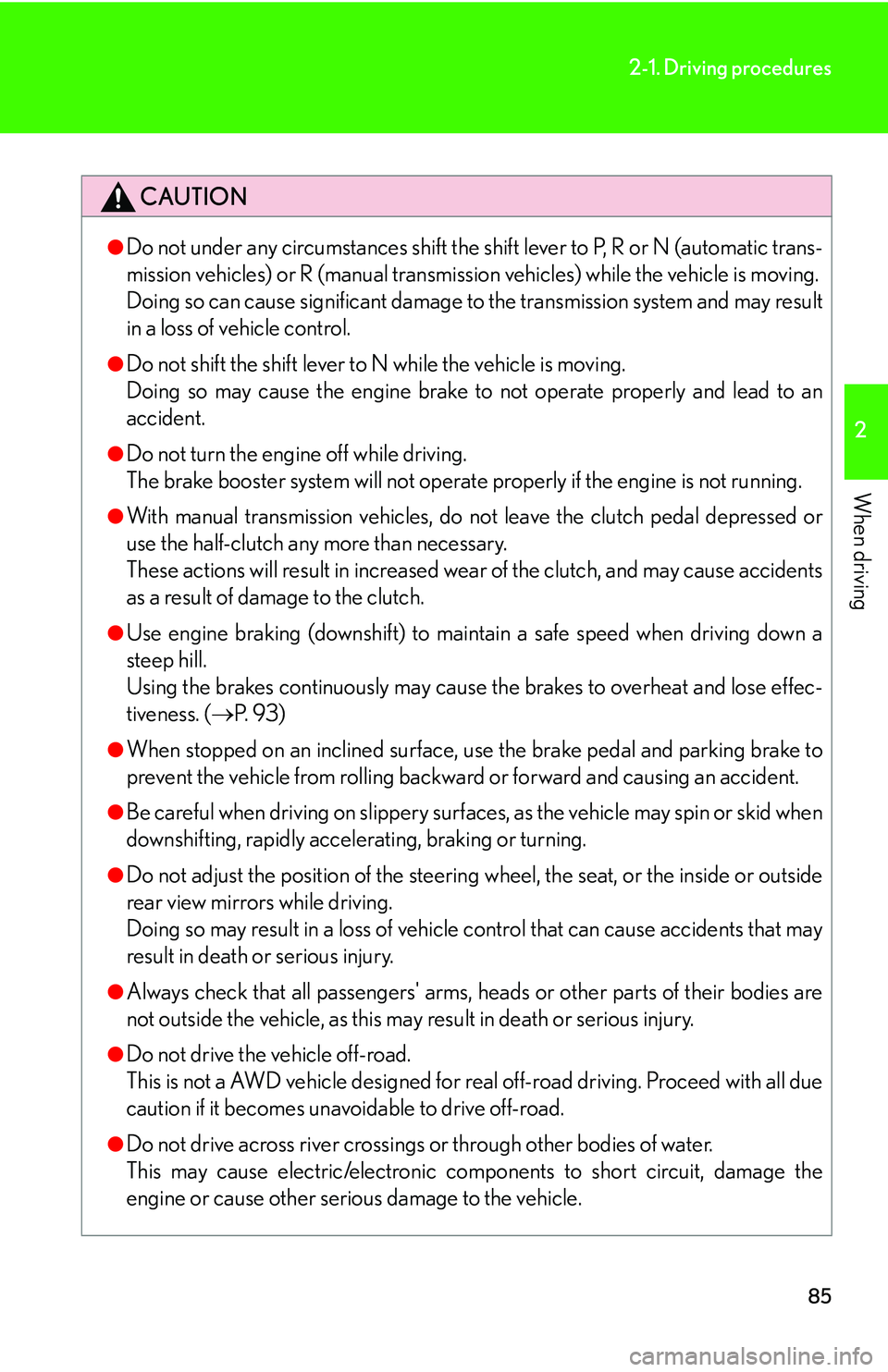
85
2-1. Driving procedures
2
When driving
CAUTION
●Do not under any circumstances shift the shift lever to P, R or N (automatic trans-
mission vehicles) or R (manual transmission vehicles) while the vehicle is moving.
Doing so can cause significant damage to the transmission system and may result
in a loss of vehicle control.
●Do not shift the shift lever to N while the vehicle is moving.
Doing so may cause the engine brake to not operate properly and lead to an
accident.
●Do not turn the engine off while driving.
The brake booster system will not operate properly if the engine is not running.
●With manual transmission vehicles, do not leave the clutch pedal depressed or
use the half-clutch any more than necessary.
These actions will result in increased wear of the clutch, and may cause accidents
as a result of damage to the clutch.
●Use engine braking (downshift) to maintain a safe speed when driving down a
steep hill.
Using the brakes continuously may cause the brakes to overheat and lose effec-
tiveness. ( P. 9 3 )
●When stopped on an inclined surface, use the brake pedal and parking brake to
prevent the vehicle from rolling backward or forward and causing an accident.
●Be careful when driving on slippery surfaces, as the vehicle may spin or skid when
downshifting, rapidly accelerating, braking or turning.
●Do not adjust the position of the steering wheel, the seat, or the inside or outside
rear view mirrors while driving.
Doing so may result in a loss of vehicle control that can cause accidents that may
result in death or serious injury.
●Always check that all passengers' arms, heads or other parts of their bodies are
not outside the vehicle, as this may result in death or serious injury.
●Do not drive the vehicle off-road.
This is not a AWD vehicle designed for real off-road driving. Proceed with all due
caution if it becomes unavoidable to drive off-road.
●Do not drive across river crossings or through other bodies of water.
This may cause electric/electronic comp onents to short circuit, damage the
engine or cause other serious damage to the vehicle.
Page 104 of 433
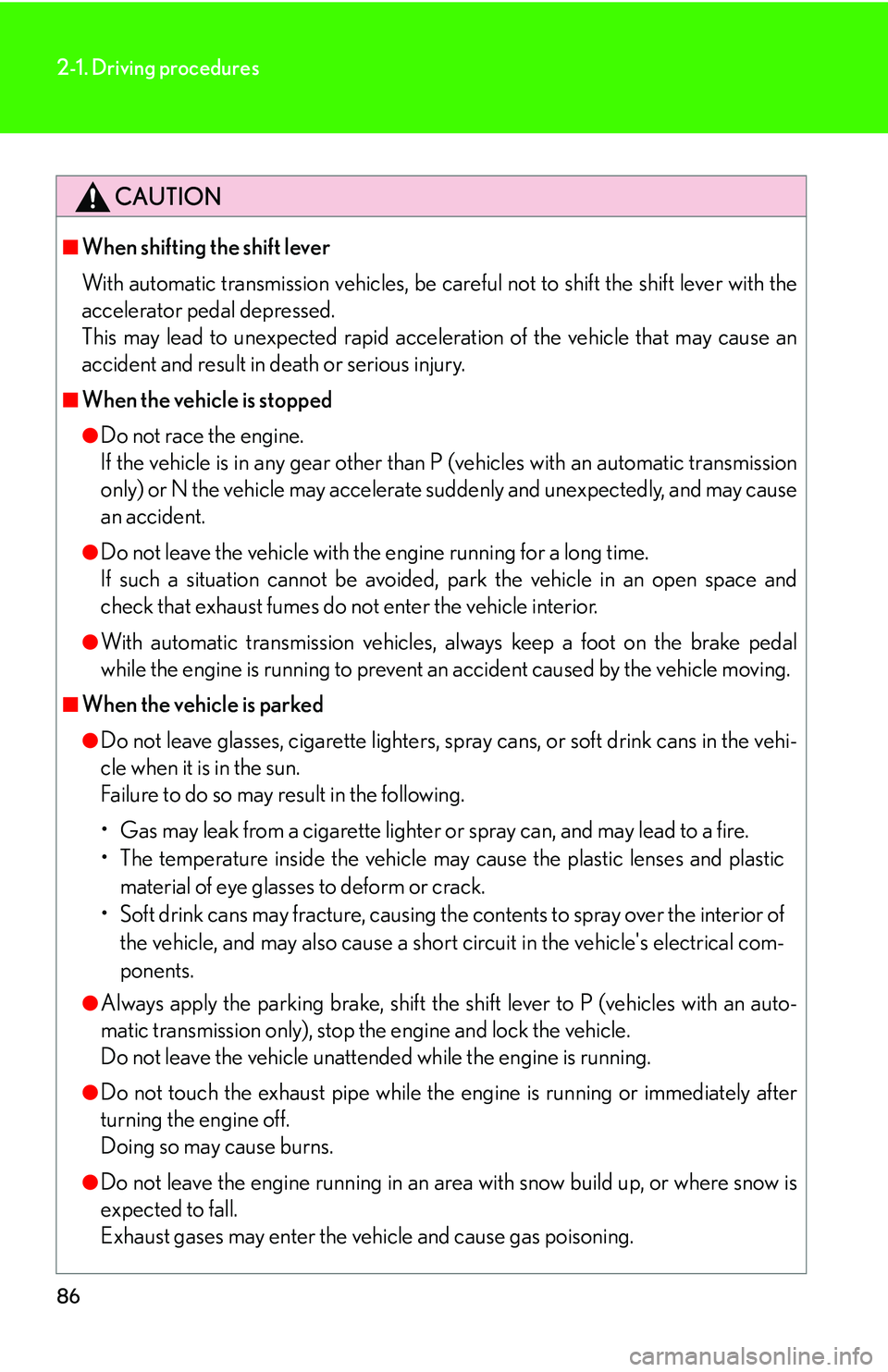
86
2-1. Driving procedures
CAUTION
■When shifting the shift lever
With automatic transmission vehicles, be careful not to shift the shift lever with the
accelerator pedal depressed.
This may lead to unexpected rapid acceleration of the vehicle that may cause an
accident and result in death or serious injury.
■When the vehicle is stopped
●Do not race the engine.
If the vehicle is in any gear other than P (vehicles with an automatic transmission
only) or N the vehicle may accelerate suddenly and unexpectedly, and may cause
an accident.
●Do not leave the vehicle with the engine running for a long time.
If such a situation cannot be avoided, park the vehicle in an open space and
check that exhaust fumes do no t enter the vehicle interior.
●With automatic transmission vehicles, always keep a foot on the brake pedal
while the engine is running to prevent an accident caused by the vehicle moving.
■When the vehicle is parked
●Do not leave glasses, cigarette lighters, spray cans, or soft drink cans in the vehi-
cle when it is in the sun.
Failure to do so may result in the following.
• Gas may leak from a cigarette lighter or spray can, and may lead to a fire.
• The temperature inside the vehicle may cause the plastic lenses and plastic material of eye glasses to deform or crack.
• Soft drink cans may fracture, causing the contents to spray over the interior of
the vehicle, and may also cause a short circuit in the vehicle's electrical com-
ponents.
●Always apply the parking brake, shift the shift lever to P (vehicles with an auto-
matic transmission only), stop the engine and lock the vehicle.
Do not leave the vehicle unattend ed while the engine is running.
●Do not touch the exhaust pipe while the engine is running or immediately after
turning the engine off.
Doing so may cause burns.
●Do not leave the engine running in an area with snow build up, or where snow is
expected to fall.
Exhaust gases may enter the vehicle and cause gas poisoning.
Page 107 of 433
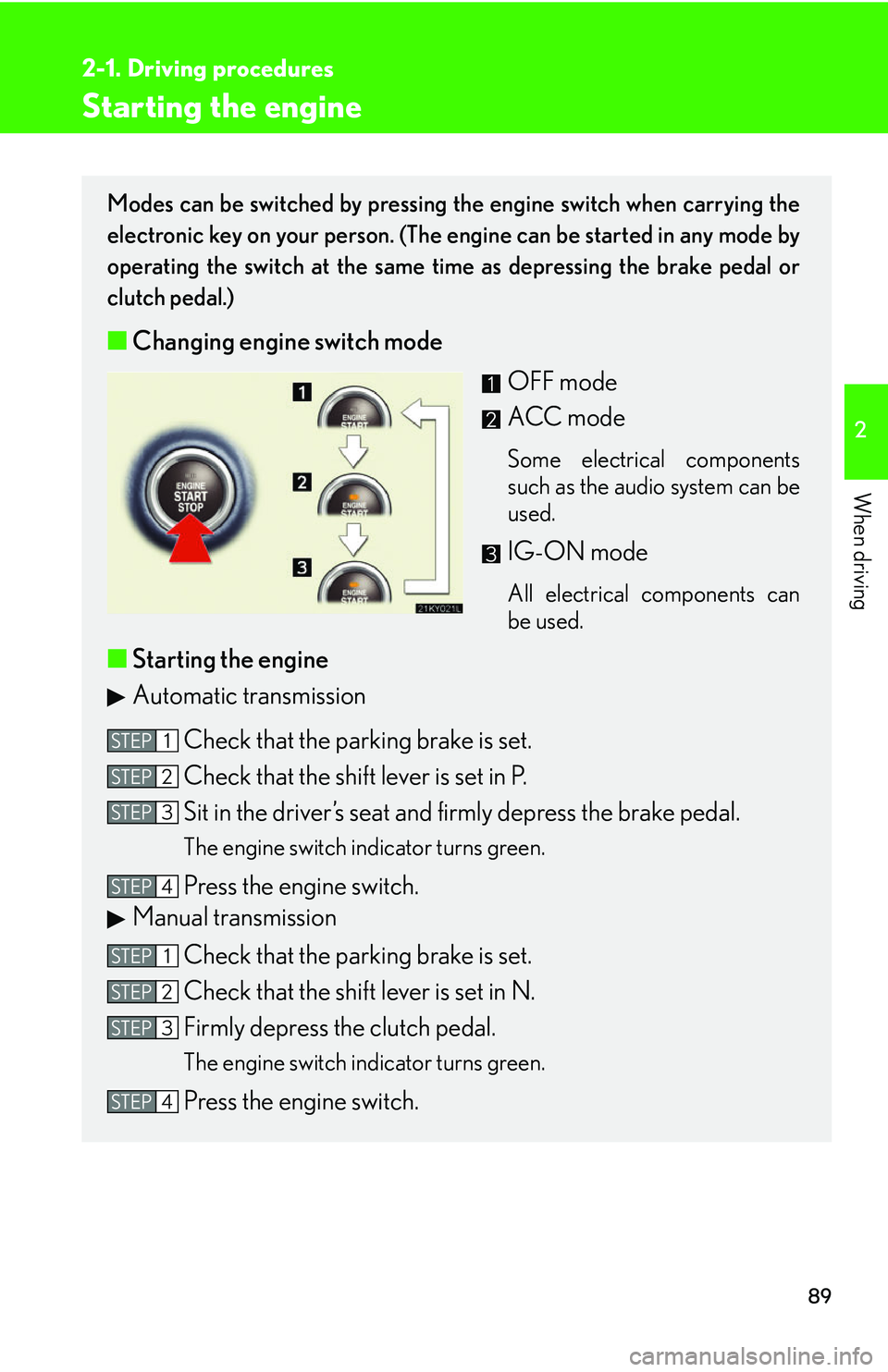
89
2-1. Driving procedures
2
When driving
Starting the engine
Modes can be switched by pressing the engine switch when carrying the
electronic key on your person. (The engine can be started in any mode by
operating the switch at the same time as depressing the brake pedal or
clutch pedal.)
■ Changing engine switch mode
OFF mode
ACC mode
Some electrical components
such as the audio system can be
used.
IG-ON mode
All electrical components can
be used.
■Starting the engine
Automatic transmission
Check that the parking brake is set.
Check that the shift lever is set in P.
Sit in the driver’s seat and firmly depress the brake pedal.
The engine switch indicator turns green.
Press the engine switch.
Manual transmission
Check that the parking brake is set.
Check that the shift lever is set in N.
Firmly depress the clutch pedal.
The engine switch indicator turns green.
Press the engine switch.
STEP1
STEP2
STEP3
STEP4
STEP1
STEP2
STEP3
STEP4
Page 109 of 433
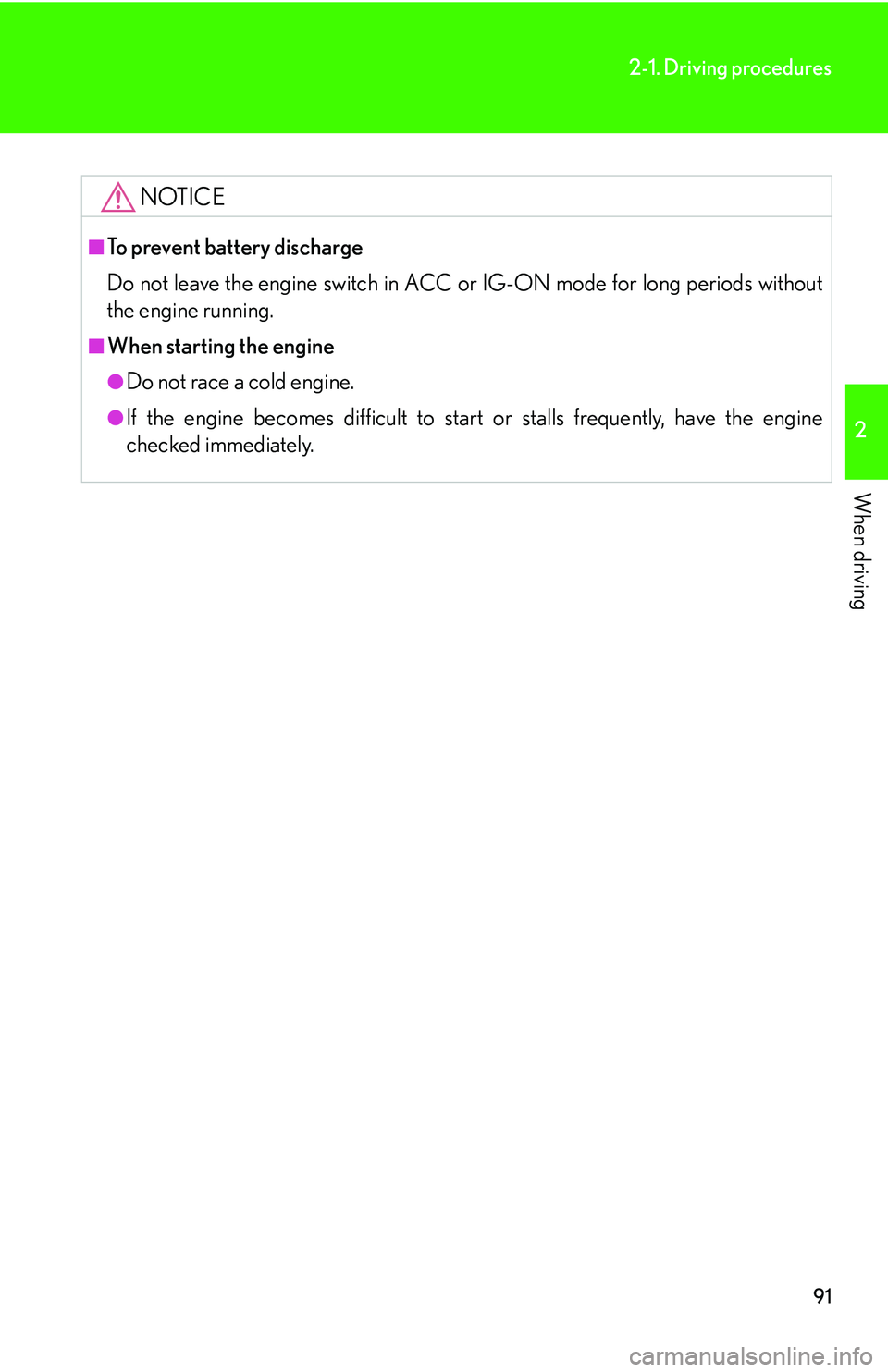
91
2-1. Driving procedures
2
When driving
NOTICE
■To prevent battery discharge
Do not leave the engine switch in ACC or IG-ON mode for long periods without
the engine running.
■When starting the engine
●Do not race a cold engine.
●If the engine becomes difficult to start or stalls frequently, have the engine
checked immediately.
Page 116 of 433
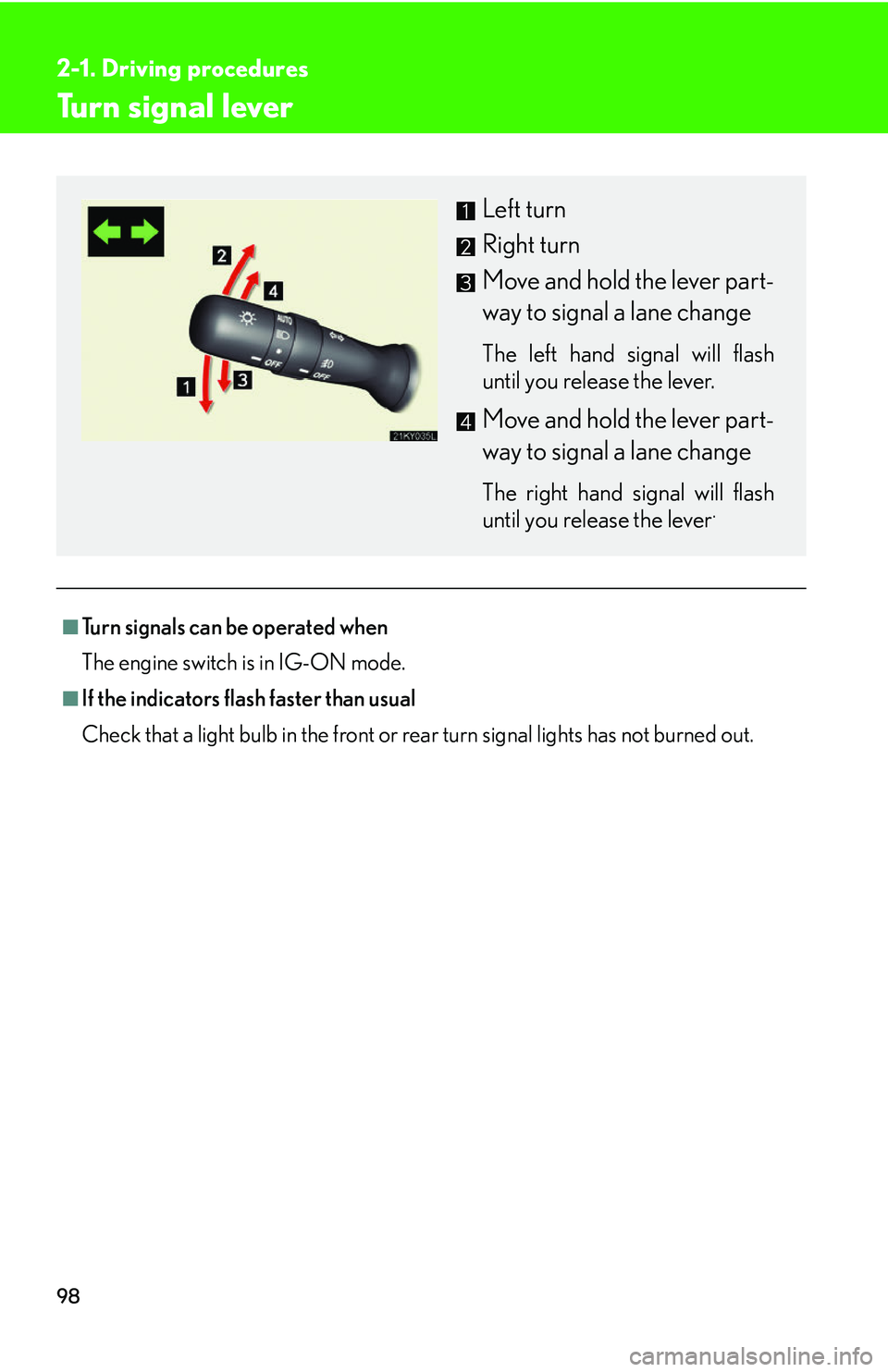
98
2-1. Driving procedures
Turn signal lever
■Turn signals can be operated when
The engine switch is in IG-ON mode.
■If the indicators flash faster than usual
Check that a light bulb in the front or rear turn signal lights has not burned out.
Left turn
Right turn
Move and hold the lever part-
way to signal a lane change
The left hand signal will flash
until you release the lever.
Move and hold the lever part-
way to signal a lane change
The right hand signal will flash
until you release the lever.
Page 123 of 433
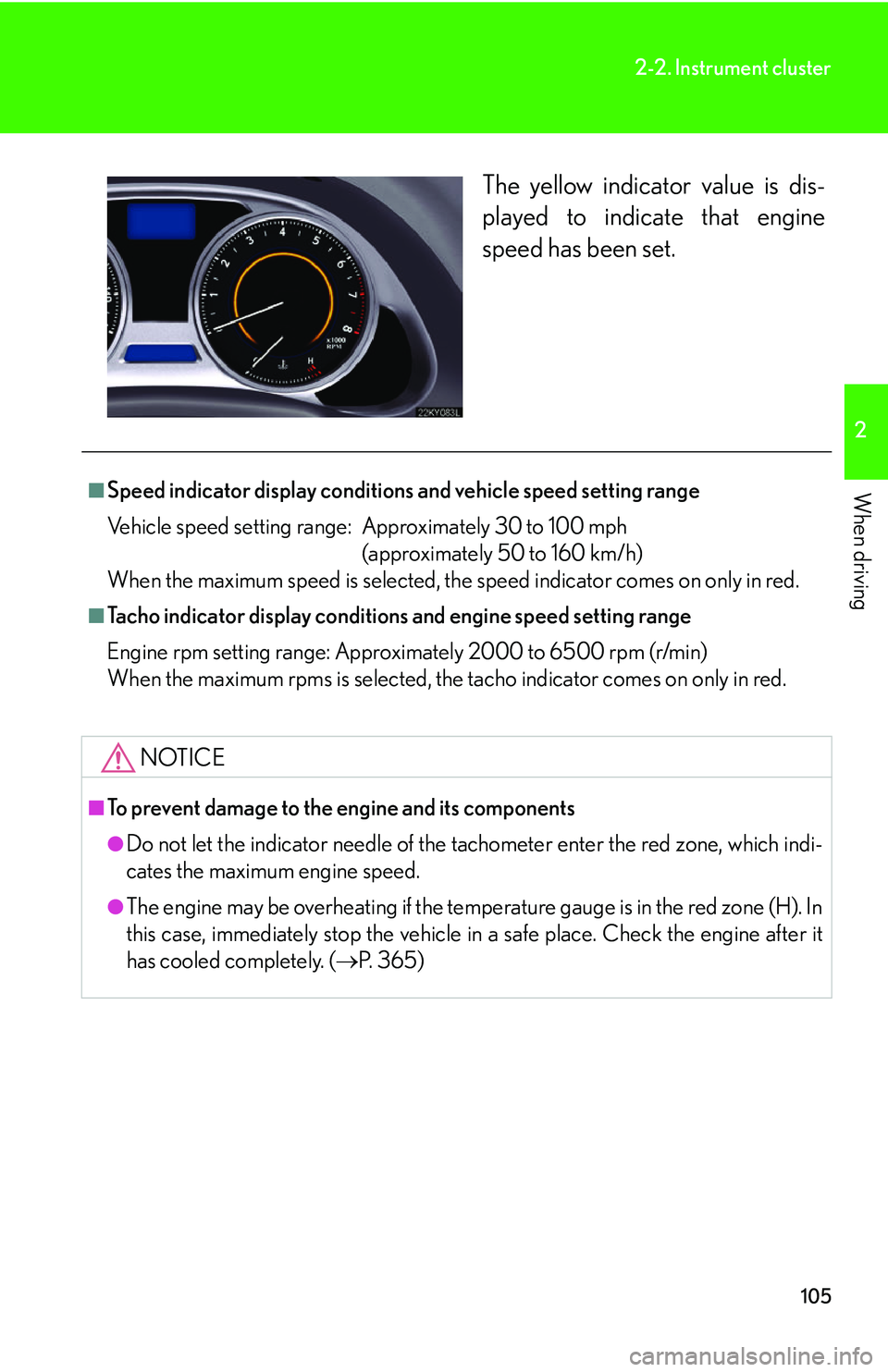
105
2-2. Instrument cluster
2
When driving
The yellow indicator value is dis-
played to indicate that engine
speed has been set.
■Speed indicator display conditions and vehicle speed setting range
Vehicle speed setting range: Approximately 30 to 100 mph (approximately 50 to 160 km/h)
When the maximum speed is selected, the speed indicator comes on only in red.
■Tacho indicator display conditions and engine speed setting range
Engine rpm setting range: Approximately 2000 to 6500 rpm (r/min)
When the maximum rpms is selected, the tacho indicator comes on only in red.
NOTICE
■To prevent damage to the engine and its components
●Do not let the indicator needle of the tachometer enter the red zone, which indi-
cates the maximum engine speed.
●The engine may be overheating if the temperature gauge is in the red zone (H). In
this case, immediately stop the vehicle in a safe place. Check the engine after it
has cooled completely. (P. 3 6 5 )